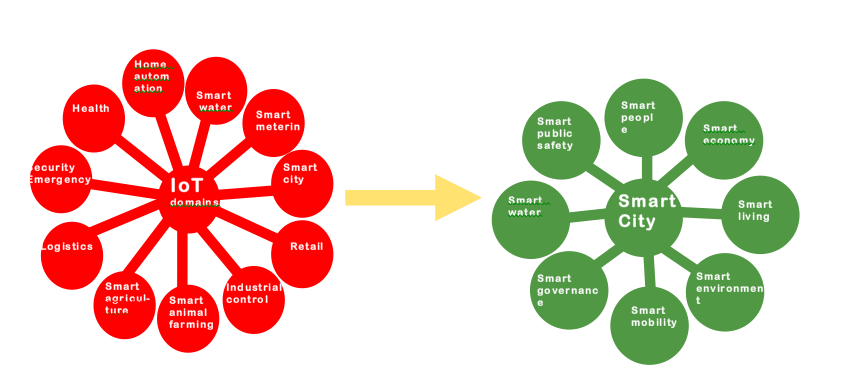The “smart city” discussion is now about thirty years old, having been stimulated by phenomena in the public and private sectors that emerged simultaneously. In short, the rapid growth of cities—especially in Asia and Africa—and an increasing need for the efficient delivery of services in all urban places regardless of the level of development collided with advances in technology, especially the growth of the all-encompassing but unintegrated Internet of Things (IoT) led by industry and academia.
The resulting conditions yielded an appetite to incorporate the new know-how into several sectors at the ground level. Many cities are engaging in projects that involve: 1) gathering city-wide big data for mapping, setting up sensor networks to deliver services; or 2) enhancing public participation through crowdsourcing, issuing complaints or visualization of proposed development projects; or 3) addressing sectoral issues including transportation, energy efficiency in lighting and buildings, public safety, air pollution, solid waste disposal, and others. The idea is moving beyond improving service delivery to enhancing inclusion and sustainability – that is the social, economic and environmental quality of life of all urban citizens. See Figure 1.
Figure 1: From ICT Applications to Smart Cities
(adapted from Petrolo et al “Towards a Smart City…” Journal of Urban Technology 2017[1])

Reams of scholarly and popular articles have appeared along with specialized publications, and cities around the world are adopting their own versions of smart cities technologies. A recent study of smart city applications in 15 places around the world concludes that while the technologies are available and relatively easy to implement, knowing which ones will be best for a given jurisdiction is not clearly understood by all parties – government leaders, private sector providers, and citizens. [2]
Smart cities inquiries and applications are global issues. In the United Nations’ recent development agreements, New Urban Agenda and Agenda 2030, the 193 UN member states committed to adopting smart-city approaches and deeply recognized their use in seven Sustainable Development Goals: Goal 6[water], Goal 7 [energy], Goal 8 [entrepreneurship], Goal 9 [infrastructure], Goal 11 [cities], Goal 13 [climate change] and Goal 17 [partnerships].
So, as we look across the landscape here in the United States, we are concurrently trying to keep up with the trends in this field while undertaking research to answer the key questions revolving around how to analyze the way forward for the various parties seeking to harness the benefits of smart city investments.
On January 18, SMARTCITIESDIVE, a Washington, DC-based digital newsletter, launched the new year with a thought-provoking article, “6 trends that will define smart cities in 2018” while a week later in Philadelphia, Penn IUR Fellows displayed such real-time smart city applications as eye-tracking glasses to demonstrate bike safety hazards, street sensors to enforce clear bike lanes, and energy efficiency models for buildings at “Smart Cities, From Innovation to Reality,” a convening sponsored by the Office of the Provost’s Year of Innovation initiative. The former exercise broadly speculated about the next big steps in this highly active field while the latter drilled into some basic questions as illustrated by the ESI ThoughtLab’s Smarter Cities 2025: Building a Sustainable Business and Financing Plan. We explore these two efforts below.
Trends for 2018
The SMARTCITIESDIVE authors noted that in 2017 more cities across the nation were managing their technology initiatives more systematically either through smart cities comprehensive plans or integration in existing mobility or other sectoral plans. Philadelphia’s Office of Innovation & Technology (OIT), joined that effort in 2017 when it launched SmartCityPHL, a strategic initiative developing a comprehensive plan to guide investment and implementation of smart technology for government service innovation. The work exemplified by Philadelphia’s effort SMARTCITIESDIVE’s Trend #1 of “Equitable Innovation,” making sure that no one is left behind in any digital modernization project.
For Trend #2 SMARTCITIESDIVE is betting on electric vehicles. The authors foresee growth in the EV infrastructure. They argue that EVs have not taken off due to the lack of refueling stations beyond residential outlets. They point to state incentives and industry investment to remedy the gap.
Trend #3, the authors predict, is a faster roll-out of 5G technology. This, they argue, will enable much faster response time for sensors and communication among the items covered by the Internet of Things (IoT). Public safety cameras, autonomous vehicles, and public internet would all benefit.
Given the five-day security breach that brought the City of Atlanta to its knees in March and other well-publicized invasions, it’s not surprising that the hardening of systems is taking center stage, thus making Trend #4, “Cybersecurity.” Since prognosticators hold that the world will host some 55 billion IoT devices by 2025 (up from about 9 billion in 2017) this offensive is critical.
In keeping with the issue of cybersecurity, “Blockchain” emerges as Trend #5. Here, the authors recognize its multiple uses, including smart contracts for billing, and facilities management or for energy sharing now being developed by a number of companies. They also add – maybe tongue in cheek – that Moscow is using it to inaugurate e-voting. Before you get too excited, be warned that this would be for reporting potholes, not electing leaders!
Last but not least is Trend #6, “Microtransit,” a form of ride-sharing that serves the “first and last” mile connections to a public transit system. Cities are expected to take a page from the private sector here, banking on on-call small vehicles to form a hybrid system to serve the elderly, disabled, or underserved people living in low income, rural, and suburban neighborhoods.
Finding the Value Proposition in Smart Cities
So will these trends play out? Right now, ESI ThoughtLab’s Smarter Cities 2025: Building Sustainable Business and Financing Plan, is exploring them and many others in an ambitious research program to be completed within the year. The aim is to provide city leaders across the globe with insights, benchmarking tools, and performance impact platforms to guide them in developing successful smart cities for the future.
Using evidence-based analysis, the study will benchmark smart city progress across 100 cities worldwide. Cognizant that cities are at different levels of development, it will segment the sample into three types, major urban hubs in developed markets (medium to large populations with relatively high GDP per capita), transitioning and lower growth cities in developed markets (medium to large populations with slowing economic growth and flat GDP per capita) and emerging market cities (emerging markets with large low-income populations). It will do in-depth studies in nine exemplar cities, building models that will quantify the costs and benefits of smart city investments in such areas as governance, mobility, environment, public safety, living standards, and others. Guiding the study are the following questions:
- Who is the future city user: How will technological, demographic, and market shifts transform the behavior of consumers and businesses in cities?
- Government, infrastructure, mobility: What steps are successful smart cities taking across different dimensions— such as governance, infrastructure, and transit—to meet the needs of local citizens and businesses?
- Community development: In what ways will cities innovate to improve economic opportunity, prosperity, and living standards for citizens across income levels in the future?
- Enabling technologies: How will forward-looking cities harness smarter technologies, such as artificial intelligence, the sharing economy, blockchain, IoT, and biometrics to drive performance?
- Economic development: What can cities do to transform themselves into future business hubs of talent and innovation? Which smart city initiatives and skill sets will be most important in the future?
- Urban policy and finance: What are the most effective business plans for creating and funding the smart city of the future? What ROI should citizens, businesses, and governments expect?
For urbanists, the smart city arena is an enormous frontier. Many questions are being pursued with regard to integrating and developing its elements in the service of sustainable urban development. Staying abreast of the trends while making sure that the applications are secure and fit for purpose are the key challenges to be addressed today.
[1] Riccardo Petrolo, Valeria Loscrì and Nathalie Mitton (2017) Towards a Smart City based on Cloud of Things, A Survey on the Smart Vison and Paradigms, Transactions in Communications Technologies, 28:e2931, DOI: 10.1002/ett.2931
[2]Margarita Angelidou (2017) The Role of Smart City Characteristics in the Plans of Fifteen Cities, Journal of Urban Technology, 24:4, 3-28, DOI: 10.1080/10630732.2017.1348880



